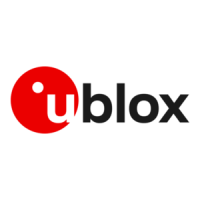NINA-B3 series - System integration manual
UBX-17056748 - R13 Regulatory information and requirements Page 58 of 72
C1-Public
More information on registration as a Responsible Integrator and labeling requirements will be found
at the following websites:
Australian Communications and Media Authority web site http://www.acma.gov.au/.
New Zealand Radio Spectrum Management Group web site www.rsm.govt.nz.
5.8 South Africa regulatory compliance
The NINA-B3 modules are compliant and certified by the Independent Communications Authority of
South Africa (ICASA). End products that are made available for sale or lease or is supplied in any other
manner in South Africa shall have a legible label permanently affixed to its exterior surface. The label
shall have the ICASA logo and the ICASA issued license number as shown in the figure below. The
minimum width and height of the ICASA logo shall be 3 mm. The approval labels must be purchased
by the customer’s local representative directly from the approval authority ICASA. A sample of a
NINA-B3 ICASA label is included below:
More information on registration as a Responsible Integrator and labeling requirements will be found
at the following website:
Independent Communications Authority of South Africa (ICASA) web site - https://www.icasa.org.za
5.9 Integration checklist
The following checklist can be used to get an overview of the requirements of each market. It is in no
way a complete list of all actions required but should cover the essentials of integrating a NINA-B3
radio module.
General requirements
The SWD interface cannot be accessed by an end product user.
Specific to the European market
The E.I.R.P of the end product is measured to be within the applicable limit.
A Class-2 limited power source is used to supply the module.
A Declaration of Conformity has been created.
Specific to the US and Canadian markets
(NINA-B30) A Change in ID/Multiple Listing has been performed.
(NINA-B3x1) The antenna connector reference design has been followed and a pre-approved
antenna is used with the end product. If not, then u-blox has been contacted to get approval to
make changes and/or add a new antenna.
(NINA-B30) If 802.15.4 is used, the radio channel 26 has been disabled and end product users’
cannot enable it.
The fundamental and out of band emissions of the end product has been measured and complies
with the applicable limits.
An SDoC has been created, or an accredited test lab has been used to certify the end product.
The end product labelling requirements are fulfilled.

